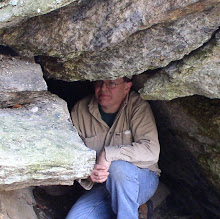Several years ago a small cave was discovered in the southern Berkshires. This would normally not cause much of a stir, but what resulted was of modest interest. The 'cave discovery' was in a geologic formation know as a 'carbonate sliver', which, in this region, is a portion of marbles usually surrounded by insoluble rocks.
Analysis of the local bedrock geology maps, revealed several other of these 'slivers' in the area, including a previously known cave off to the north. Today was the day devoted to examining those other slivers, plus returning to the cave I visited once before - probably around 50 years ago. So starting our trek, Rhode Island Mountain Man and myself, first passed by a flooded Carbonate Sliver Cave (recent discover) on to the north. Out in the middle of nowhere, we examined the location of two slivers, lying in relatively close proximity to one another. The first showed almost no exposure of rock - the second, an insignificant depression adjacent to a sharp hill, being the sliver itself.
Following the drainage north from this sliver/hillock, we eventually arrived at the sliver containing the 'major' cave in the area. Unfortunately, the perimeter around the cave was feeding significant water to the underground. Although access was gained to the cave's entrance room, the passages beyond suffered from fill.
The journey out provided at chance for a further examination of the sliver with little rock exposure. Back near the beginning, we looked down into the flooded passages of the more recent discovery.
Later that week, we dropped down into northern Connecticut for an attempt at finding the elusive Dutchy's Cave. The large flows of water that were noticed earlier in the week were even more omnipresent. We had a number of stream crossings to make and it was made difficult by these water levels. Much trudging about did not gain us our goal. We did have the pleasure of passing by Turtle Rock, on the Naugatuck River, during the journey.


















































